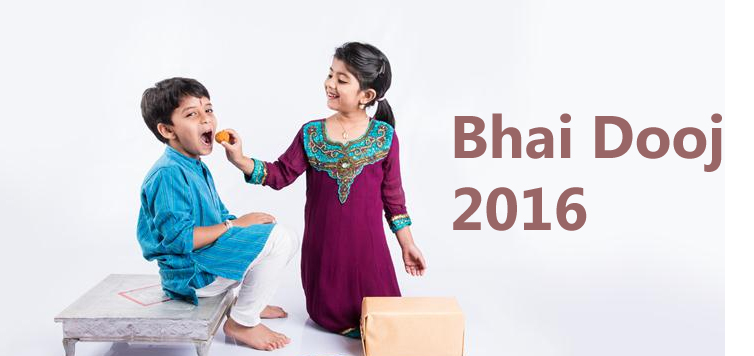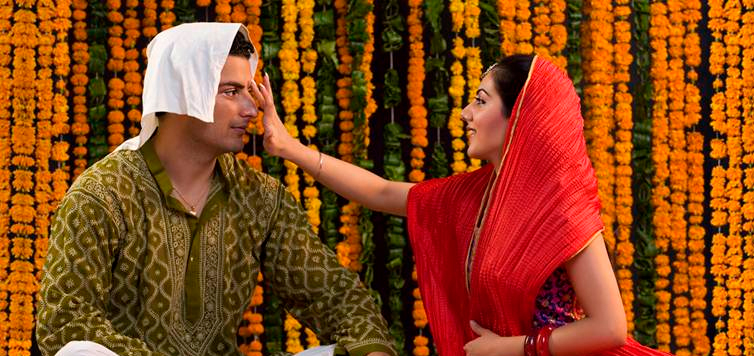Pathankot City

Bhai Dooj 2016
We are in the last phase of Diwali celebrations that concludes with the ritual of Bhai Dooj. The five-day Diwali celebrations that start with Dhanteras on the first day and Lakshmi Puja on the thirst day end with celebrating the bond between brother and sister on the last day. It a festival very similar to Raksha Bandhan but unlike Rakhi, no thread is tied on their hands. Brothers vows to protect sisters, while the sister prays for brother’s long life and well being.
It is celebrated on the second day after the new moon or Shukla Paksha in the Hindu lunar month of Kartik (falling most between months of October and November). The auspicious second day is also known as ‘dooj’ or ‘dwithiya’, thus giving it the name Bhai Dooj or Bhathru Dwithiya.
Celebrated in many parts of India and Nepal it is an important festival in Bengal, Bihar and parts of Gujarat and Maharastra. Bhai Dooj is also called as Bhau Beej (in Goa, Maharashtra and Karnataka), Bhai Tika (in Nepal), Bhathru Dwithiya, Bhau-deej, Bhai Phota (in Bengal), and Ningol Chakuba (in Manipur).
Origin and significance of the festival:
There are two main stories that are believed to have given rise to this festival of celebrating the bond between brother and sister. In several parts of India it is believed that Lord Krishna, after killing Narakasur, one of the asura kings, went to meet his beloved sister Subhadra. Subhadra welcomed him in the traditional way by performing aarti and putting a tilak on his forehead after his remarkable victory. Many believe is the history behind the ceremony.
However, in a parallel history the ritual is associated with Yamraj, the god of death. This day is also known as Yamadwitheya or Yamadvitiya. According to Hindu Mythology it is said that on the second day after the new moon, Yamraj visited his sister Yami (also known as Yamuna). The grand meeting was started with aarti and tilak ceremony followed by a sumptuous meal. In return of all the love and grand gesture, Yamraj had returned her sister a unique gift as a symbol of his love and care towards his sister. At that day being happy by Yami’s care and affection, Yamraj had declared that any brother, who would visit his sister and receive tilak and aarti on the dwithiya of Sukla Paksha in the Kartik month, should not fear death.

Another story behind the origin of Bhai Dooj says that when Mahavir, the founder of Jainism, attained nirvana and shunned all family ties, his brother King Nandivardhan was extremely upset because he missed him and was comforted by his sister Sudarshana. Many attribute this to the ceremony too.
It is believed that Yamraj and Yami were estranged twin children of Lord Surya but was driven out by their step-mother Chaya. The meeting of Yamiraj and Yamuna on this day happened after prolonged period of several years and Yamraj was extremely touched by her love. By the time they met, Yamuna was married to a prince and Yamraj was welcomed in her husband’s house. Thereby many believe traditionally this festival is applicable to married women only.
Apart from strengthening the bond, it gave a chance for the brother to visit and check on the conditions of his sister at her husband’s place. So traditionally brothers visit sister on this day and are treated with great regard along with sweets and gifts. It is also believed that Yamraj’s promise to Yami about the longevity of life assured to brothers to receive love from their sister on this day is also significant. Believing that Yamraj listens to sisters’ prayers and stay away from their brothers rewarding them long life.
In present-day world sisters both unmarried and married celebrate the occasion with much fanfare and galore and is incomplete with delicious meal and desserts.
Ceremony or Vidhi:
The ceremony is marked by the sisters putting an auspicious tilak or a vermilion mark on the forehead of their brothers and performs an aarti of him by showing him the light of the holy flame as a mark of love and protection from evil forces. Sisters in return get gifts, goodies and blessings from their brothers.
The tilak ceremony however has many variations. In Nepal, seven colours are used to adorn the forehead of the brothers. In Bengal, sandal paste and kajal is used to put the tilak and is blessed with dhaan (paddy grain) and durba (grass) also signifying money or gifts are not needed for brother’s blessing.
Meals:
During the tilak ceremony the brother is treated with many sweets and desserts which are followed by an elaborate meal at lunch. In Maharashtra, special dishes for the festival include the sweet called basundi poori or kheerni poori. In Bengal a special snack glazed with sugary syrup called the khaja is essential to the festival. No thali served to the brother during the tilak ceremony is complete with this.
SOURCE: goo.gl/hq2iK8
2016 bhai dooj, bhai duj in india, bhai dooj calendar, bhai dooj puja, bhai dooj wishes, bhai dooj festival, bhai dooj messages, bhai dooj wishes, bhai dooj vidhi, bhai dooj importance, significance of bhai dooj, celebrate bhaiduj, bhai dooj story, Bhai Dooj 2016 celebration, Bhai Dooj 2016 vidhi
Copyright © 2024 About Pathankot | Website by RankSmartz ( )
)